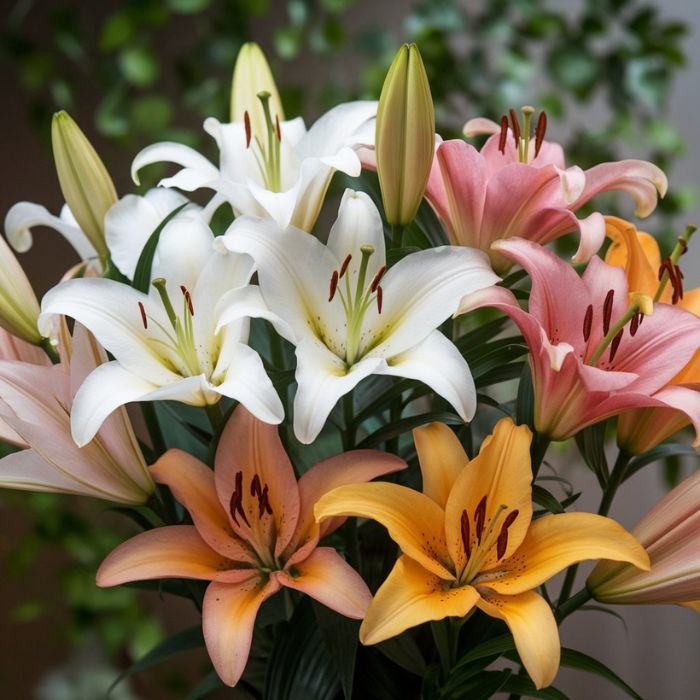The Beautiful World of Lilies: Types and Growing Tips
Lilies are some of the most beloved and diverse flowers in the world, known for their stunning beauty, fragrance, and symbolism. Whether you’re a gardening enthusiast or a floral lover, lilies can transform any space with their elegance and charm. This article will delve into the different types of lilies, their characteristics, and how to care for them.
What Are Lilies?
Lilies (genus Lilium) belong to the family Liliaceae and are native to the temperate regions of the Northern Hemisphere. They are known for their large, trumpet-shaped blooms that come in a wide range of colors, including white, pink, red, orange, and yellow. These perennial flowers are often associated with purity, renewal, and beauty.
Lilies are highly adaptable and can thrive in various climates and soil conditions, making them a favorite for gardeners and landscapers alike. The diversity of lilies is vast, with over 90 species and countless hybrids. Below, we’ll explore some of the most popular types of lilies and provide tips on how to grow them.
Types of Lilies
1. Asiatic Lilies
Asiatic lilies are among the most popular and easiest lilies to grow. They come in a wide array of vibrant colors and are known for their upward-facing blooms. These lilies are usually the first to bloom in the early summer and are excellent for adding color to gardens.
- Color: White, yellow, orange, red, pink
- Bloom time: Early to mid-summer
- Care: Asiatic lilies prefer well-drained soil and full sun to partial shade. They are low-maintenance and can tolerate various soil types, making them a great choice for beginners.
2. Oriental Lilies
Oriental lilies are prized for their large, fragrant blooms and striking colors. These lilies often bloom later in the summer and have a stronger fragrance compared to Asiatic lilies. Their tall stems and large flowers make them ideal for creating a dramatic effect in the garden.
- Color: White, pink, red, often with dark speckles or stripes
- Bloom time: Mid to late summer
- Care: Oriental lilies prefer acidic soil and require more attention than Asiatic lilies. They thrive in well-drained, slightly acidic soil and full sun. Mulching around the plants helps retain moisture and keeps the roots cool.
3. Trumpet Lilies
True to their name, trumpet lilies have large, trumpet-shaped flowers that are highly fragrant. These lilies can grow quite tall, often reaching up to 6 feet in height, making them a statement piece in any garden.
- Color: White, yellow, pink, orange
- Bloom time: Mid-summer
- Care: Trumpet lilies need well-drained soil and full sun. Staking may be required to support the tall stems. Regular watering is essential during the growing season, but avoid overwatering as it can lead to root rot.
4. Tiger Lilies
Tiger lilies are known for their unique, orange blooms with dark spots, giving them a distinctive appearance. These lilies are hardy and easy to grow, making them a great choice for gardeners who want low-maintenance plants.
- Color: Bright orange with black spots
- Bloom time: Mid to late summer
- Care: Tiger lilies thrive in a variety of soil types but prefer well-drained, loamy soil. They can grow in both full sun and partial shade, and they are relatively resistant to pests and diseases.
5. LA Hybrid Lilies
LA hybrid lilies are a cross between Longiflorum and Asiatic lilies, combining the best traits of both. They have larger flowers than Asiatic lilies and a mild fragrance, making them perfect for cut flowers and garden displays.
- Color: White, yellow, pink, orange, red
- Bloom time: Early to mid-summer
- Care: These lilies are easy to grow and prefer well-drained soil with full sun exposure. Regular watering and fertilizing will help them thrive.
6. Martagon Lilies
Martagon lilies, also known as Turk’s Cap lilies, are characterized by their downward-facing blooms and recurved petals. These lilies are often found in woodlands and are perfect for shaded garden areas.
- Color: Pink, purple, white, yellow
- Bloom time: Early to mid-summer
- Care: Martagon lilies prefer well-drained, rich soil and thrive in partial shade. They can take a few years to establish but are worth the wait for their unique beauty.
7. Longiflorum Lilies (Easter Lilies)
Easter lilies are famous for their pure white, trumpet-shaped blooms and are often used in floral arrangements, especially during the Easter season. These lilies have a subtle fragrance and are relatively easy to grow.
- Color: White
- Bloom time: Early summer
- Care: Easter lilies prefer well-drained, sandy soil and full sun to partial shade. They need regular watering, especially during dry spells.
How to Grow and Care for Lilies
Lilies are relatively easy to grow as long as they are planted in the right conditions. Here are some general tips to help your lilies thrive:
1. Planting
- Time: The best time to plant lily bulbs is in the fall, as this gives them time to establish their roots before winter.
- Soil: Lilies prefer well-drained soil. If your soil is heavy or clay-like, consider amending it with organic matter such as compost.
- Depth: Plant lily bulbs about 6 to 8 inches deep, with the pointed end facing upward. Space them about 12 to 18 inches apart to give them room to grow.
2. Light Requirements
Most lilies thrive in full sun, but some varieties, like Martagon lilies, can tolerate partial shade. Aim for at least 6 hours of sunlight per day for optimal growth.
3. Watering
Lilies need regular watering, especially during dry spells. However, be careful not to overwater, as this can cause the bulbs to rot. Water the base of the plant rather than the leaves to avoid fungal diseases.
4. Fertilizing
Fertilizing lilies in the spring and during the growing season will promote healthy blooms. Use a balanced fertilizer or a bulb-specific fertilizer to nourish the plants.
5. Mulching
Applying mulch around the base of the plants helps retain moisture, keep the roots cool, and suppress weeds. Organic mulch, such as straw or wood chips, is a great option.
6. Deadheading and Pruning
Remove spent blooms to encourage more flowering and prevent the plant from putting energy into seed production. After the flowering season, allow the foliage to die back naturally before cutting it down.
7. Pest and Disease Management
Lilies are generally hardy, but they can be affected by pests such as aphids, lily beetles, and slugs. Regularly inspect your plants and remove any pests by hand or use an organic insecticide. Fungal diseases like botrytis can also affect lilies, so ensure good air circulation around the plants and avoid overhead watering.
Conclusion
Lilies are a wonderful addition to any garden, offering a wide variety of colors, shapes, and fragrances. From the bold Asiatic lilies to the graceful Oriental varieties, there is a lily for every gardening style. By following the care tips provided, you can enjoy these stunning flowers year after year.

